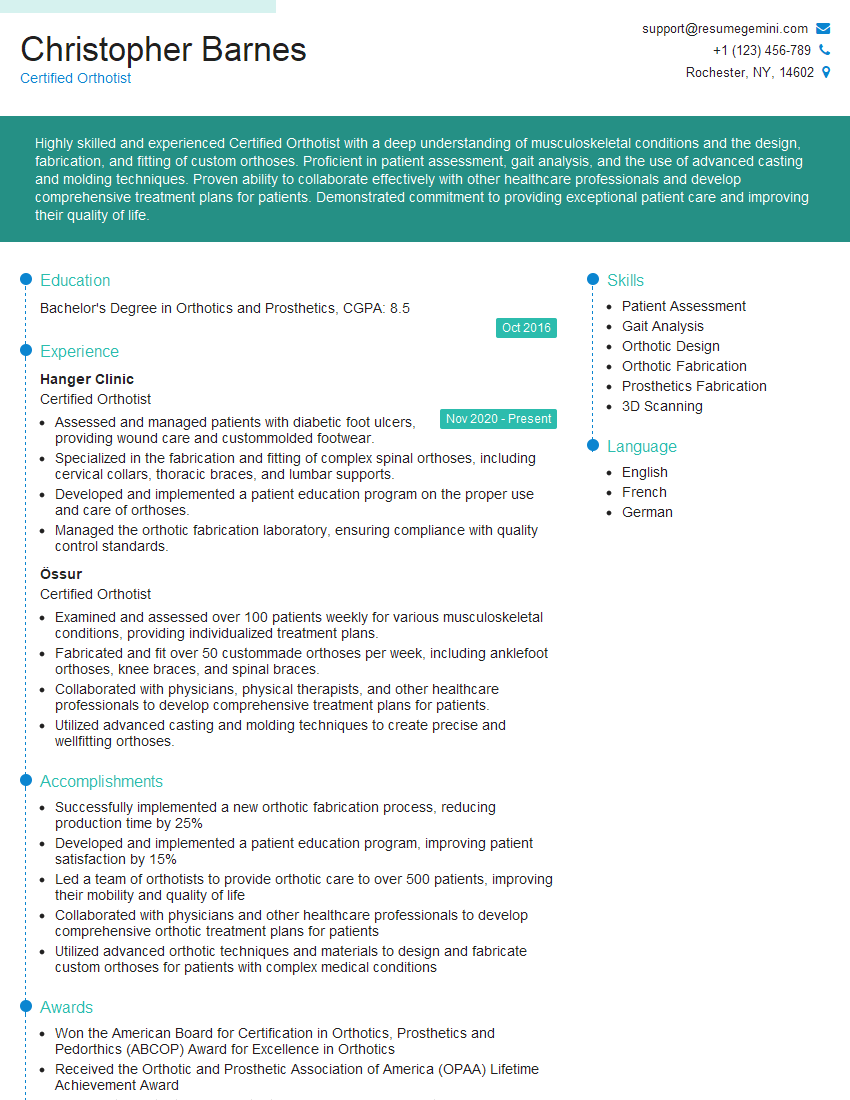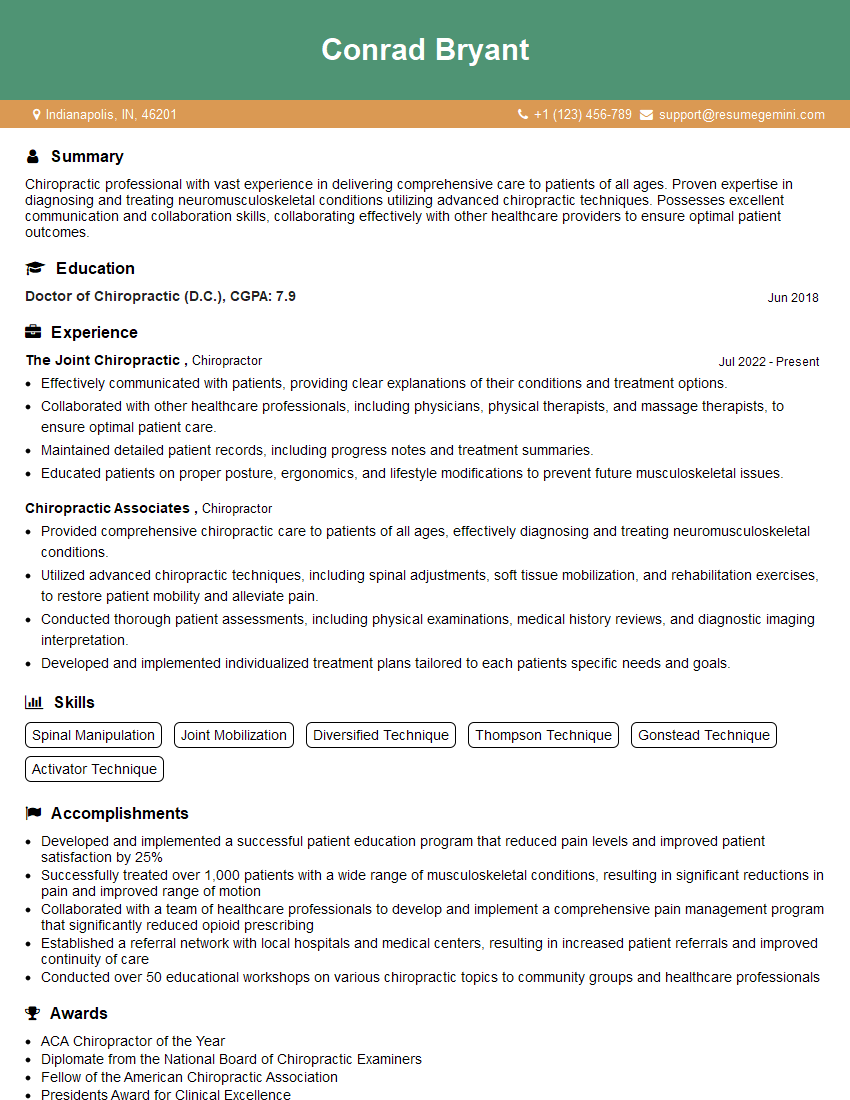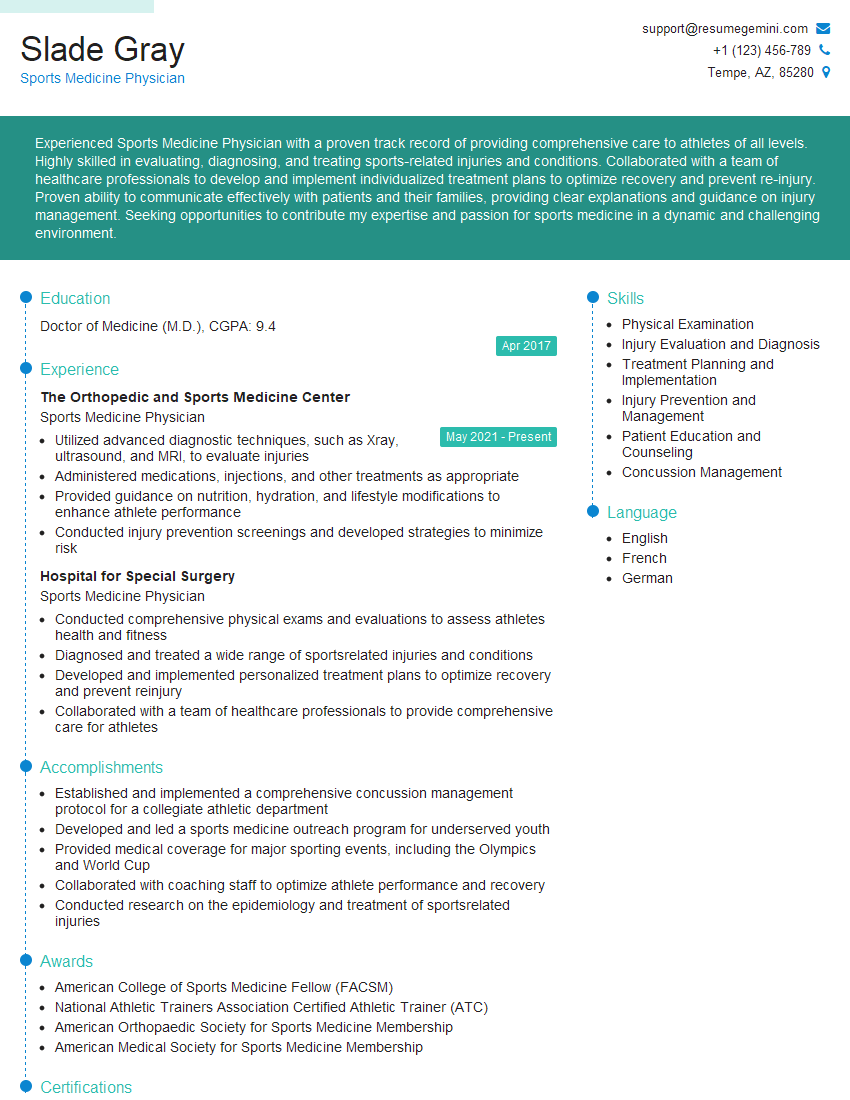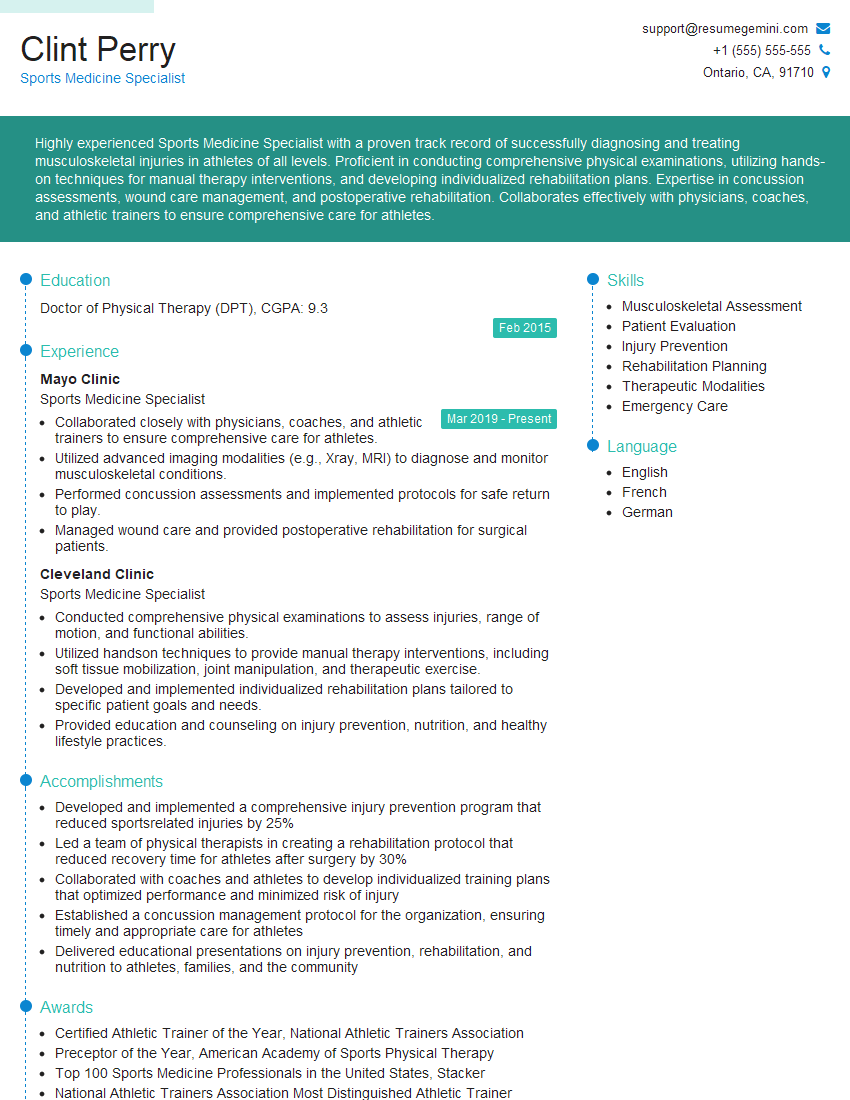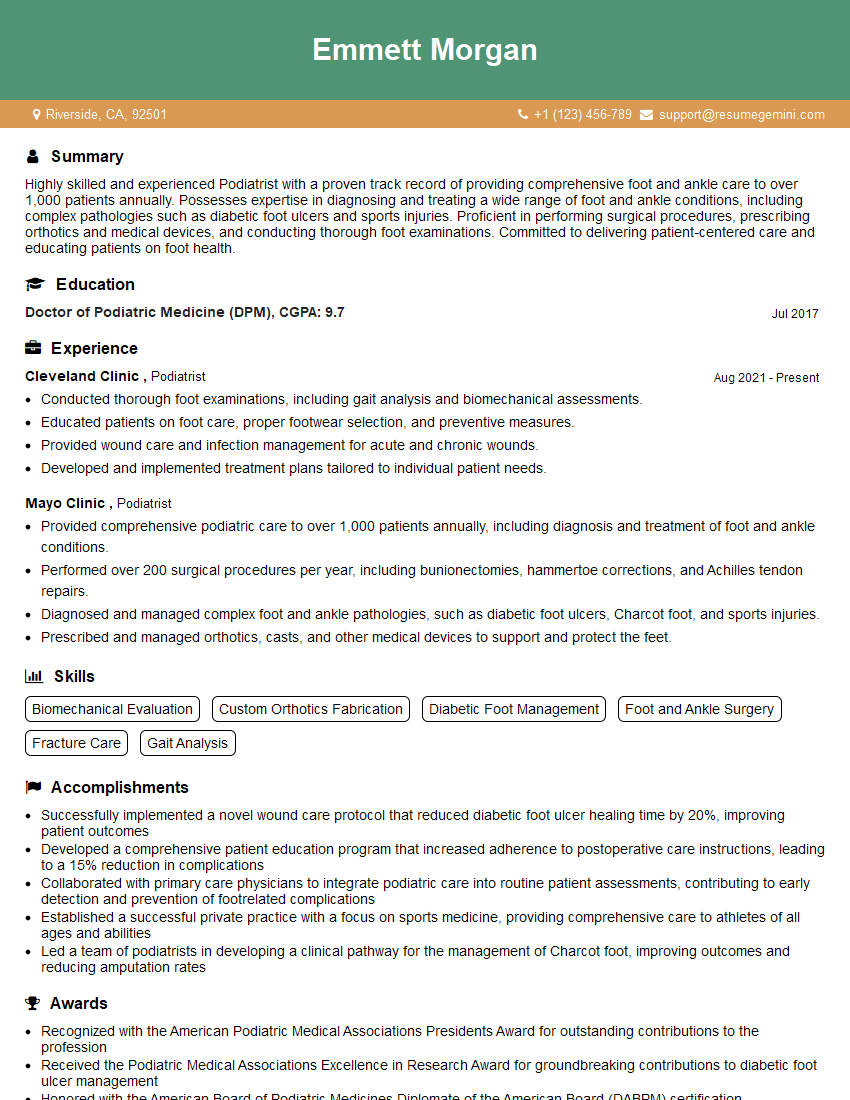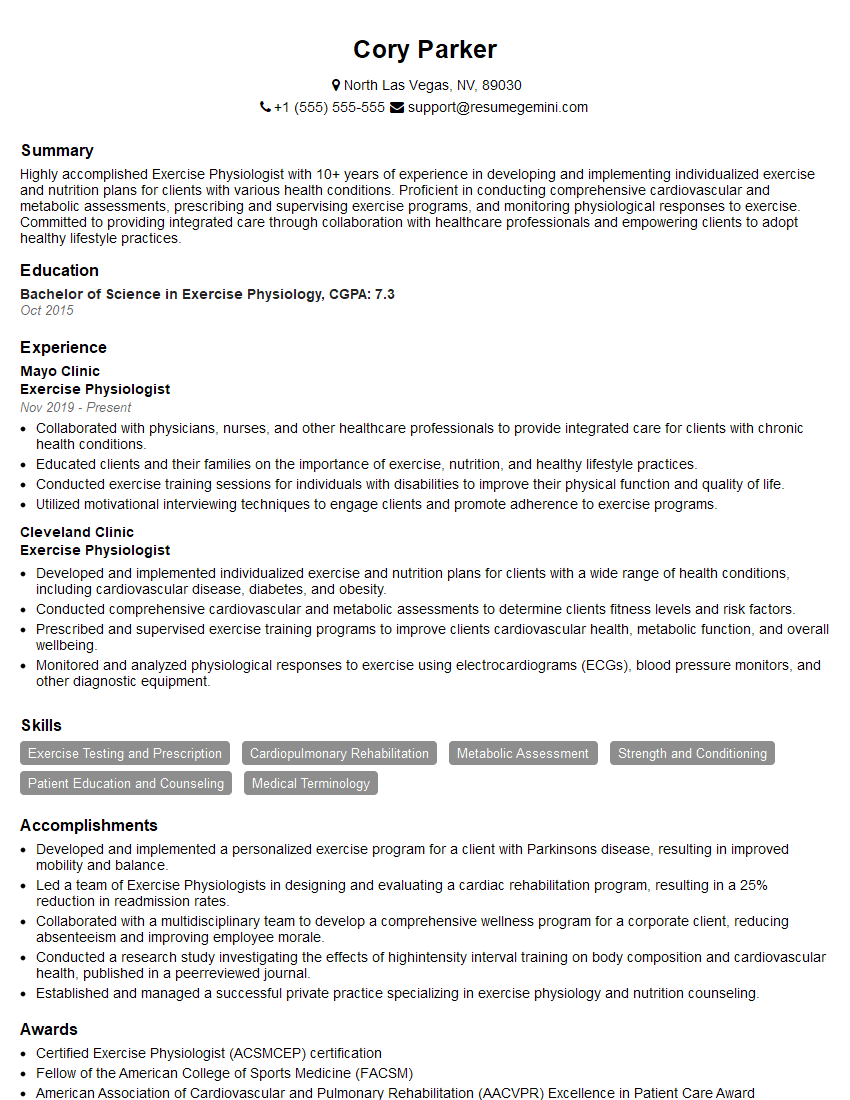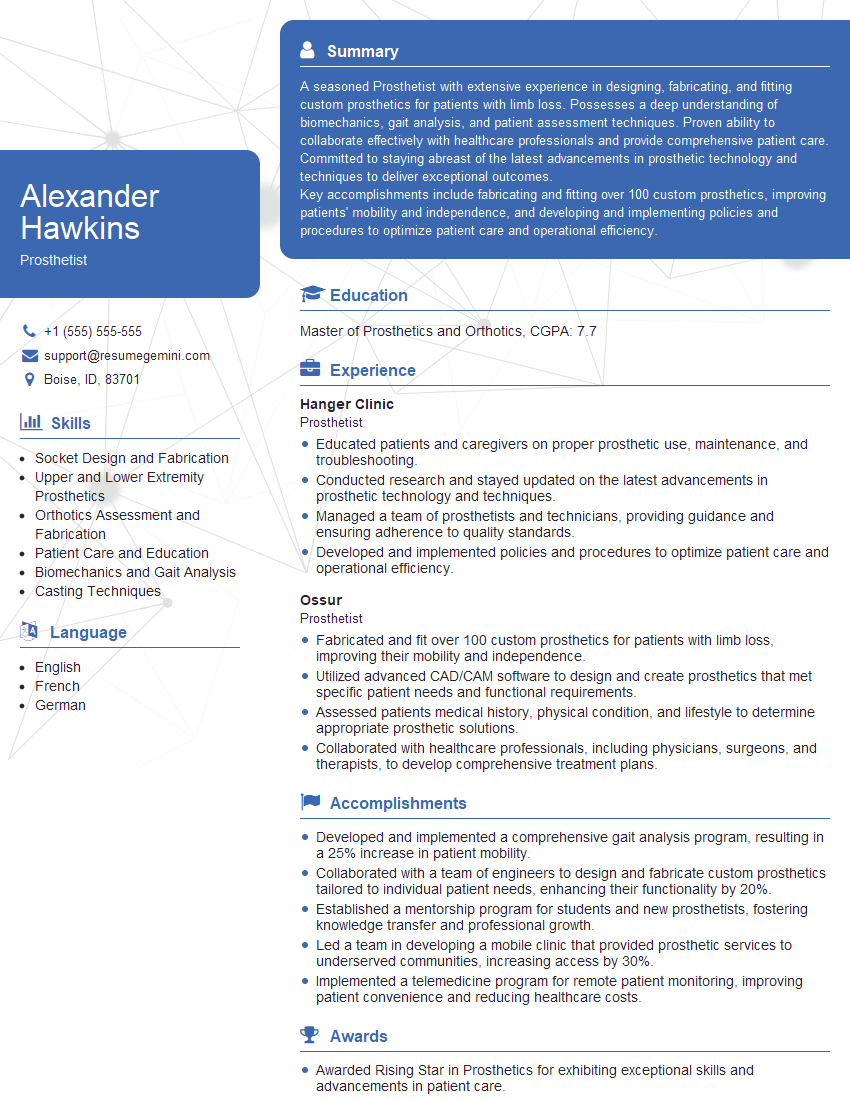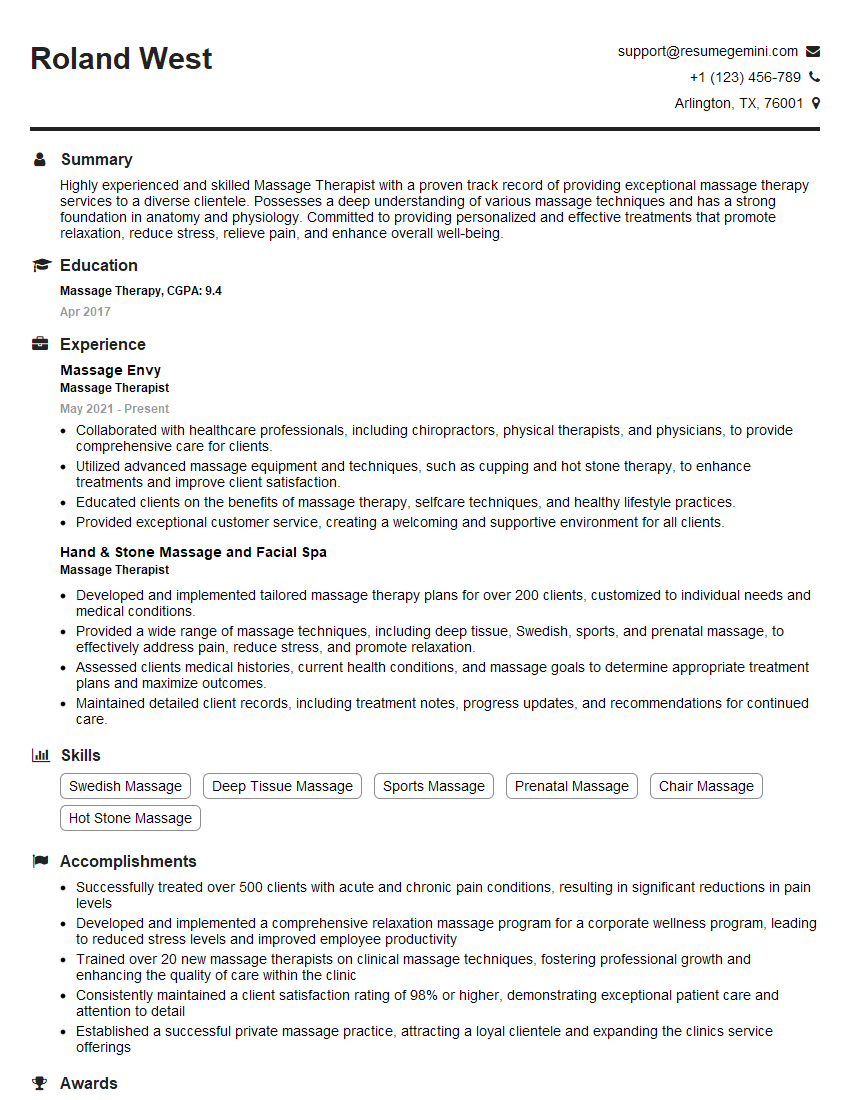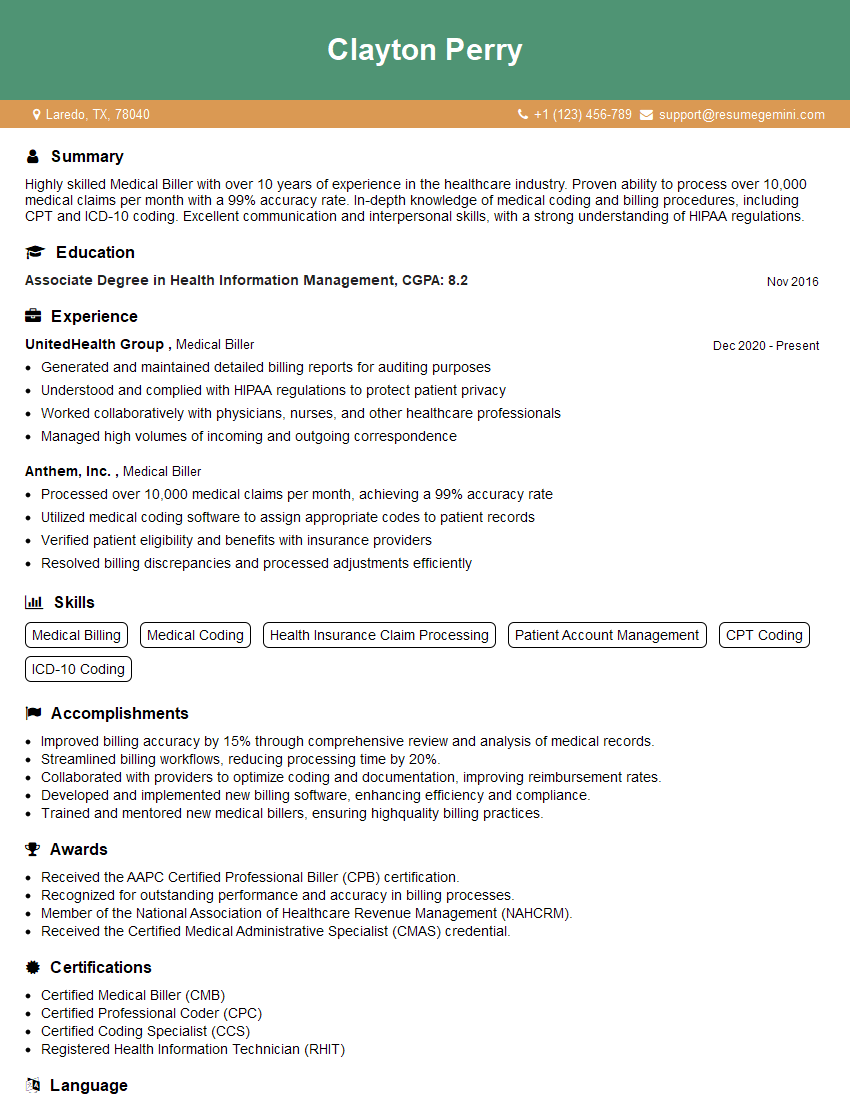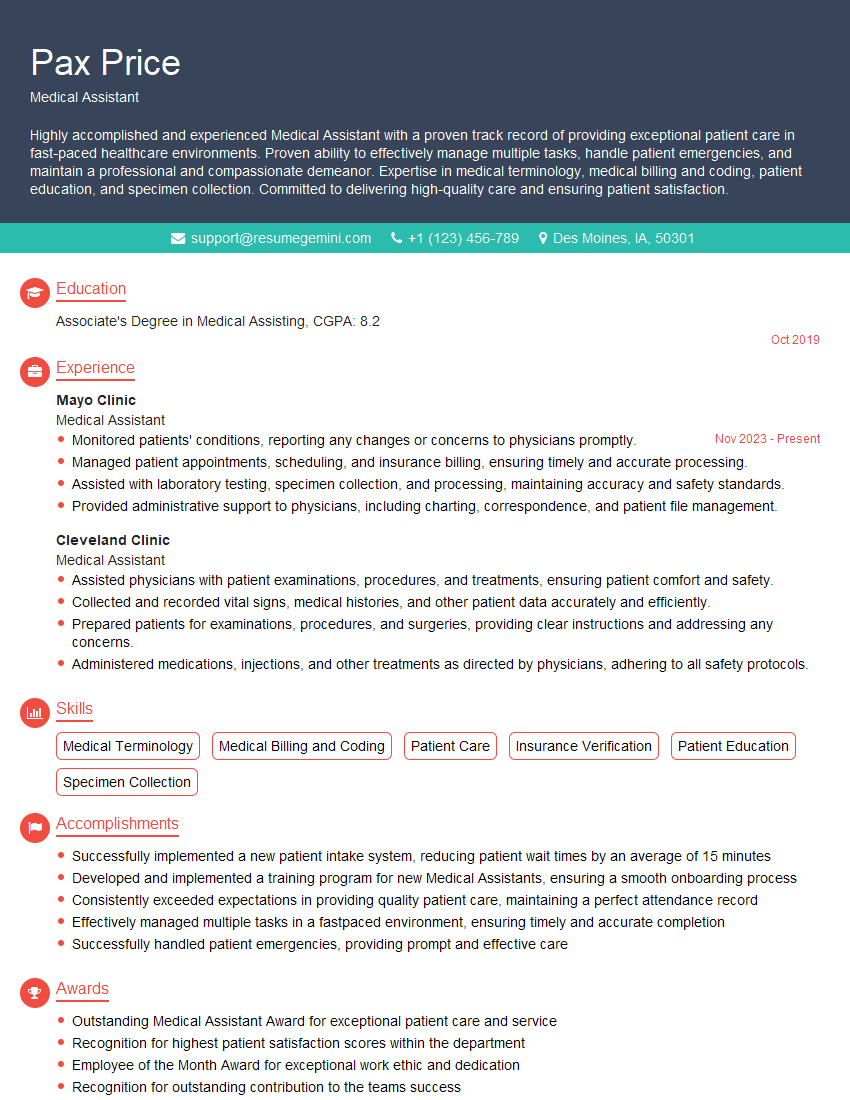Every successful interview starts with knowing what to expect. In this blog, we’ll take you through the top Ankle Sprains and Fractures interview questions, breaking them down with expert tips to help you deliver impactful answers. Step into your next interview fully prepared and ready to succeed.
Questions Asked in Ankle Sprains and Fractures Interview
Q 1. Describe the Ottawa Ankle Rules.
The Ottawa Ankle Rules are a clinical decision rule used to determine whether an ankle X-ray is necessary after an ankle injury. They’re designed to help clinicians quickly and efficiently identify patients who require imaging to detect fractures, avoiding unnecessary X-rays while ensuring that those who need them receive appropriate care. The rules are based on the presence or absence of specific clinical findings that are associated with a higher risk of fracture.
- Bone tenderness at the posterior edge or tip of the medial or lateral malleolus: This refers to pain when pressure is applied to the bony prominences on the inner and outer aspects of the ankle.
- Bone tenderness at the base of the fifth metatarsal: Pain on palpation at the base of the small toe bone.
- Bone tenderness at the navicular bone: Pain on palpation at the inner side of the midfoot, near the arch.
- Inability to bear weight immediately after the injury and for four steps during the initial examination: This is the most significant criterion; the patient’s ability to weight-bear is assessed immediately after the injury and during the physical exam. If they can’t put weight on it even for a few steps, that significantly increases suspicion for a fracture.
If any of these criteria are present, an ankle X-ray is indicated. This helps avoid unnecessary radiation while ensuring patients with fractures receive prompt treatment.
Q 2. Differentiate between a Grade I, II, and III ankle sprain.
Ankle sprains are graded based on the severity of ligament damage:
- Grade I Sprain (Mild): This involves stretching or minor tearing of the ligament fibers. There is minimal swelling and pain, and the ankle remains relatively stable. You might experience mild discomfort and some limitations in range of motion. Think of it like stretching a rubber band – it’s still intact but a bit stretched.
- Grade II Sprain (Moderate): This involves a partial tear of the ligament. The ankle is more unstable and shows moderate swelling, bruising, and pain. There is likely significant functional impairment – walking is more difficult and painful. This is like partially tearing the rubber band – it’s still somewhat intact, but significantly weakened.
- Grade III Sprain (Severe): This involves a complete tear of the ligament. The ankle is significantly unstable, and there is often substantial swelling, bruising, and pain. Weight bearing is typically impossible or incredibly painful. This is like completely snapping the rubber band – it’s completely separated.
The grading helps guide treatment decisions. Grade I sprains typically respond well to conservative management (RICE), while Grade II and III sprains may require more extensive intervention, possibly including immobilization and physical therapy.
Q 3. What imaging modalities are used to diagnose ankle fractures?
The primary imaging modality used to diagnose ankle fractures is X-ray. Standard X-rays (anteroposterior, lateral, and mortise views) are usually sufficient to visualize most fractures of the ankle. These views provide clear images of the bones, allowing for the identification of fractures, dislocations, or other bony abnormalities. In cases where there is significant suspicion of a fracture but the X-rays are inconclusive, further imaging may be considered.
Computed tomography (CT) scans provide more detailed, three-dimensional images of the bones and can be helpful in complex fractures or when a precise assessment of fracture morphology is needed for surgical planning. Similarly, magnetic resonance imaging (MRI) scans provides detailed images of soft tissues like ligaments and tendons, and is often done in conjunction with ankle sprains to properly assess the extent of ligamentous injury. However, they’re less commonly used in the initial diagnosis of ankle fractures unless there is a high clinical suspicion of ligamentous injury as well.
Q 4. Explain the mechanism of injury for a lateral ankle sprain.
The mechanism of injury for a lateral ankle sprain (the most common type) typically involves inversion of the foot. This occurs when the foot is twisted inward while the leg remains relatively stable. This forceful inversion places excessive stress on the lateral ligaments of the ankle, particularly the anterior talofibular ligament (ATFL), the calcaneofibular ligament (CFL), and the posterior talofibular ligament (PTFL). Imagine stepping off a curb or twisting your ankle while playing basketball. The unexpected movement puts the ligaments under extreme strain leading to stretching or tearing.
The severity of the sprain depends on the force of the inversion and the degree of ligamentous damage. A less forceful inversion may result in a mild sprain (Grade I), while a more forceful inversion can result in a moderate (Grade II) or severe (Grade III) sprain.
Q 5. What are the common signs and symptoms of an ankle fracture?
The signs and symptoms of an ankle fracture vary in severity depending on the fracture type and location but commonly include:
- Severe pain: Immediately after the injury and even at rest.
- Swelling: Rapid and significant swelling around the ankle joint.
- Deformity: Visible deformity or angulation of the ankle.
- Bruising: Bruising around the injured area may develop over time.
- Inability to bear weight: Significant difficulty or inability to walk on the injured ankle.
- Crepitus: A grating or crunching sensation felt or heard when moving the ankle (indicative of bone fragments rubbing together).
- Numbness or tingling: in the foot or toes (possibly due to nerve involvement).
It’s important to note that not all fractures will have all of these symptoms. Some fractures, particularly undisplaced or minimally displaced fractures, may present with milder symptoms, making a thorough clinical examination crucial.
Q 6. Describe the appropriate initial management of an ankle sprain.
The initial management of an ankle sprain follows the RICE protocol:
- Rest: Avoid weight-bearing on the injured ankle to prevent further damage.
- Ice: Apply ice packs to the injured area for 15-20 minutes at a time, several times a day, to reduce swelling and pain. Never apply ice directly to the skin.
- Compression: Use an elastic bandage to provide compression to the ankle, supporting it and reducing swelling. The bandage should be snug but not overly tight, ensuring adequate blood flow.
- Elevation: Keep the injured ankle elevated above the heart as much as possible to help reduce swelling.
Over-the-counter pain relievers, like ibuprofen or acetaminophen, can help manage pain and inflammation. Early mobilization and range-of-motion exercises are generally recommended as soon as pain allows, helping to prevent stiffness and promote healing. If symptoms worsen, or if the ankle is unstable, medical attention is crucial.
Q 7. What are the potential complications of a missed or improperly treated ankle fracture?
Missed or improperly treated ankle fractures can lead to several serious complications, including:
- Malunion: The fracture heals in a misaligned position, leading to long-term pain, instability, and decreased range of motion. This can significantly impact the patient’s quality of life and functional ability.
- Nonunion: The fracture fails to heal completely, leaving a persistent gap between the fractured bone fragments. This often requires further surgical intervention to achieve healing.
- Arthritis: Damage to the articular cartilage (the smooth lining of the joint) caused by the fracture or improper healing can result in the development of osteoarthritis, causing chronic pain and stiffness.
- Chronic pain: Persistent pain and discomfort in the ankle joint can significantly impact activities of daily living. This pain can be debilitating and difficult to manage.
- Complex regional pain syndrome (CRPS): In some cases, a missed or poorly treated fracture can lead to CRPS, a complex and debilitating condition characterized by chronic pain, swelling, and changes in skin color and temperature.
- Post-traumatic arthritis: Damage to the joint surfaces during the fracture can accelerate the development of osteoarthritis.
- Instability: Improper healing can lead to long-term ankle instability, increasing the risk of recurrent sprains and further injury.
Proper diagnosis and treatment are therefore essential to minimize the risk of these complications and ensure optimal patient outcomes.
Q 8. Explain the difference between a Weber A, B, and C fracture.
Weber classifications categorize ankle fractures based on the location of the fibula fracture relative to the syndesmosis, which is the strong ligamentous connection between the tibia and fibula.
- Weber A fracture: This fracture occurs below the syndesmosis. Think of it as a break in the lower part of the fibula, below the ankle joint’s main ligaments. It’s usually considered a relatively stable fracture.
- Weber B fracture: This fracture occurs at the level of the syndesmosis. This is a fracture right at the crucial ligamentous connection. These fractures are often more unstable because the ligaments are often involved in the injury.
- Weber C fracture: This fracture occurs above the syndesmosis. This means the break is above the crucial ligamentous connection, often resulting in significant instability of the ankle joint and potentially more complex treatment. Imagine it as a break higher up on the fibula, disrupting the joint’s stability.
Understanding these classifications is crucial for determining treatment strategy because the stability of the fracture directly impacts the treatment approach.
Q 9. Describe the treatment options for a displaced ankle fracture.
Treatment for a displaced ankle fracture aims to restore proper alignment and stability. The primary options are:
- Closed Reduction and Cast Immobilization: This involves manipulating the fractured bones back into their correct positions without surgery. This is followed by immobilization in a cast or splint for several weeks to allow for healing. This is an option for some stable, minimally displaced fractures.
- Open Reduction and Internal Fixation (ORIF): This involves surgical intervention. The surgeon makes an incision, directly reduces the fracture fragments, and then uses plates, screws, or other implants to hold the bones in place while they heal. This is the preferred method for most displaced fractures to ensure proper alignment and stability.
The choice between closed and open treatment depends on factors such as the severity of the displacement, the patient’s overall health, and surgeon preference. A severely displaced fracture almost always necessitates ORIF.
Q 10. What are the indications for surgery in ankle fractures?
Surgical intervention in ankle fractures is indicated when:
- Significant displacement or angulation: When the fractured bone fragments are significantly out of alignment.
- Joint instability: When the ankle joint is unstable after attempts at closed reduction.
- Open fractures: When the fracture breaks through the skin.
- Presence of articular involvement: When the fracture involves the articular surfaces (the weight-bearing surfaces) of the ankle joint.
- Multiple fractures: Involving both the fibula and tibia.
- Failure of closed reduction: If the bones cannot be properly aligned without surgery.
Surgery aims to restore anatomical alignment, joint stability, and early weight-bearing, ultimately improving patient outcome and preventing long-term complications.
Q 11. How do you assess the stability of an ankle fracture?
Assessing ankle fracture stability involves a combination of clinical examination and imaging:
- Clinical Examination: This involves checking for tenderness, swelling, deformity, and range of motion. The examiner assesses the stability by gently stressing the ankle joint to see if there is any abnormal movement or instability.
- Imaging: X-rays are essential to visualize the fracture, its location, degree of displacement, and any associated injuries. In some cases, CT scans provide a more detailed three-dimensional image of the fracture for better assessment.
The combination of these assessments provides a comprehensive picture of the fracture’s stability, guiding the treatment decision.
Q 12. What are the common surgical techniques used for ankle fracture fixation?
Several surgical techniques are used for ankle fracture fixation:
- Plate and screw fixation: This is a common technique where plates are applied to the outside of the bone, and screws secure the fragments together. This provides excellent stability.
- Screw fixation alone: In some cases, screws alone may be sufficient to stabilize the fracture, particularly in less displaced fractures.
- Intramedullary nails: These are long nails inserted into the medullary canal (the hollow center) of the bone. This is sometimes used for certain types of fractures.
- External fixation: This involves the use of pins inserted through the skin and bone, connected to an external frame. This provides temporary stabilization while the fracture heals.
The choice of technique depends on factors such as the type and location of the fracture, the patient’s age and overall health, and surgeon preference.
Q 13. Describe the rehabilitation protocol for a patient with an ankle sprain.
Rehabilitation after an ankle sprain focuses on reducing pain and swelling, regaining range of motion, and restoring strength and stability:
- RICE protocol: Rest, Ice, Compression, Elevation in the initial phase.
- Early mobilization: Gentle range of motion exercises are started as soon as pain allows, to prevent stiffness.
- Progressive strengthening: Exercises focusing on strengthening the muscles around the ankle and lower leg are introduced gradually.
- Proprioceptive training: Exercises to improve balance and coordination are vital to prevent future sprains.
- Return to activity: A gradual return to normal activities is guided by the patient’s progress and tolerance.
The rehabilitation process is tailored to the individual’s needs and progresses in stages, often involving physical therapy.
Q 14. What are the common complications of ankle fracture surgery?
Complications of ankle fracture surgery are relatively uncommon but can include:
- Infection: A risk with any surgery.
- Nonunion: Failure of the bone to heal properly.
- Malunion: Healing of the bone in an incorrect position.
- Arthritis: Development of arthritis in the ankle joint, especially with articular involvement.
- Nerve or blood vessel damage: Rare but possible complications.
- Implant failure: Failure of the plates or screws.
- Chronic pain: Persistent pain in the ankle can occur.
Careful surgical technique and diligent post-operative care minimize these risks. Regular follow-up appointments are essential to monitor healing and address any complications promptly.
Q 15. How do you differentiate between an ankle sprain and an ankle fracture clinically?
Differentiating between an ankle sprain and an ankle fracture clinically relies on a combination of the patient’s history, a thorough physical examination, and often, imaging studies. While both result from trauma to the ankle, the severity and nature of the injury differ significantly.
Sprains involve stretching or tearing of the ligaments – the strong bands of tissue that connect bones. Clinically, you’ll often see swelling, pain, bruising (ecchymosis), and tenderness localized to the affected ligament(s). The patient may have difficulty bearing weight, and there may be instability, but typically, there’s no bone deformity. Palpation reveals localized tenderness and possibly a gap or laxity in the affected ligament.
Fractures, on the other hand, involve a break in the bone. This can range from a hairline crack to a complete break. Clinically, fractures often present with more severe pain, significant swelling, bruising, and potentially deformity or malalignment of the ankle bones. Patients frequently cannot bear weight at all. Palpation may reveal crepitus (a grating sound or sensation due to bone fragments rubbing together) and obvious bony tenderness.
Imaging is crucial. X-rays are the primary imaging modality used to confirm or rule out a fracture. A sprain, without a fracture, is typically diagnosed clinically. However, even with a suspected sprain, X-rays are often taken to exclude an occult (hidden) fracture. MRI or CT scans may be needed in complex cases to evaluate ligamentous injuries or subtle fractures.
Career Expert Tips:
- Ace those interviews! Prepare effectively by reviewing the Top 50 Most Common Interview Questions on ResumeGemini.
- Navigate your job search with confidence! Explore a wide range of Career Tips on ResumeGemini. Learn about common challenges and recommendations to overcome them.
- Craft the perfect resume! Master the Art of Resume Writing with ResumeGemini’s guide. Showcase your unique qualifications and achievements effectively.
- Don’t miss out on holiday savings! Build your dream resume with ResumeGemini’s ATS optimized templates.
Q 16. What are the common causes of ankle instability after injury?
Ankle instability after an injury, meaning the ankle gives way or feels unstable, can stem from several factors. These are frequently interconnected.
- Ligament damage: The most common cause is damage to the ligaments, particularly the anterior talofibular ligament (ATFL), calcaneofibular ligament (CFL), and posterior talofibular ligament (PTFL). Incomplete healing or significant ligamentous disruption leads to instability.
- Cartilage damage: Damage to the articular cartilage, the smooth tissue covering the ends of the bones in the ankle joint, can contribute to instability and pain.
- Bone damage: Ankle fractures, even if healed, can lead to instability if there’s malalignment or non-union (failure of the bone fragments to unite).
- Muscle weakness: Weakness in the muscles surrounding the ankle, especially the peroneal and tibialis muscles, compromises support and increases the risk of instability.
- Proprioceptive deficits: Proprioception is the body’s sense of its position in space. Injury can disrupt this sense, leading to difficulties with balance and coordination, and increased risk of ankle giving way.
Imagine the ankle as a carefully balanced tripod. Damage to any of the legs (ligaments, bones, muscles, or proprioception) affects the whole structure’s stability.
Q 17. Discuss the role of physiotherapy in the management of ankle sprains and fractures.
Physiotherapy plays a vital role in managing both ankle sprains and fractures, focusing on restoring function and preventing long-term complications.
Ankle Sprains: Physiotherapy for sprains initially involves RICE (Rest, Ice, Compression, Elevation) to control swelling and pain. This is followed by range-of-motion exercises to prevent stiffness, strengthening exercises to improve muscle strength and stability, and proprioceptive training to improve balance and coordination. Taping or bracing may be used for support. As the injury heals, activities such as walking and more advanced exercises are gradually reintroduced.
Ankle Fractures: Following fracture healing (which might involve casting or surgery), physiotherapy focuses on regaining range of motion, strengthening weakened muscles, improving proprioception, and restoring functional mobility. The process is carefully staged, starting with gentle range-of-motion exercises and progressing to weight-bearing activities as the bone heals. Early mobilization and supervised exercises are essential to prevent stiffness and improve the quality of bone healing.
Physiotherapy is tailored to the individual’s specific needs and recovery progress. It’s not a one-size-fits-all approach. For example, a high-level athlete’s rehabilitation program will differ significantly from someone with a more sedentary lifestyle. The ultimate goal is to return the patient to their pre-injury level of function.
Q 18. How do you assess for compartment syndrome in an ankle injury?
Compartment syndrome is a serious condition involving increased pressure within a confined muscle compartment, compromising blood supply to the muscles and nerves. In the ankle, this is less common than in the leg, but still a critical consideration following significant trauma.
Assessment involves a high index of suspicion. Look for the following:
- Pain disproportionate to the injury: The pain is intense and out of proportion to what you’d expect from the apparent injury.
- Swelling: Tense, firm swelling may be present.
- Paresthesia: Numbness or tingling in the affected area.
- Paralysis: Weakness or inability to move the toes or foot.
- Pulselessness: Diminished or absent pulse in the affected foot (a late sign).
The 6 Ps are often used to remember these signs: Pain, Pallor, Paresthesia, Paralysis, Pulselessness, Poikilothermia (coldness).
Immediate medical attention is crucial if compartment syndrome is suspected. It is a surgical emergency requiring fasciotomy (surgical incision to release the pressure).
Q 19. What are the potential long-term consequences of an untreated ankle fracture?
Untreated ankle fractures can have significant long-term consequences, impacting both mobility and quality of life.
- Malunion: The bones may heal in a misaligned position, leading to long-term pain, instability, and arthritis.
- Nonunion: The fracture may fail to heal, resulting in persistent pain and instability. This may require further surgery.
- Arthritis: Damage to the articular cartilage caused by the fracture can lead to the development of osteoarthritis, with chronic pain, stiffness, and reduced range of motion.
- Chronic pain: Even with seemingly successful healing, some patients experience persistent pain and discomfort, impacting their daily activities.
- Instability: Improper healing can lead to long-term ankle instability, making it prone to recurrent sprains and injuries.
- Limb length discrepancy: Severe fractures can sometimes result in one leg being shorter than the other, impacting gait and posture.
These complications emphasize the importance of prompt and appropriate medical care for all ankle fractures.
Q 20. Explain the importance of proper footwear in preventing ankle injuries.
Proper footwear plays a crucial role in preventing ankle injuries. The right shoes provide support, cushioning, and stability, minimizing the risk of sprains and fractures.
- Support: Shoes with good arch support help maintain the natural alignment of the foot and ankle, reducing strain on the ligaments.
- Cushioning: Adequate cushioning absorbs shock, protecting the ankle from impact forces during activities like running or jumping.
- Stability: A stable base prevents excessive rolling or twisting of the ankle, reducing the risk of injury.
- Fit: Shoes that fit properly are essential. Shoes that are too tight or too loose can compromise support and increase the risk of injury.
- Appropriate activity: Choosing footwear appropriate for the activity you’re doing is crucial. Hiking boots for hiking, running shoes for running, etc.
Think of your shoes as the foundation for your ankle’s stability. Just as a poorly built house is prone to collapse, an unsupported ankle is more susceptible to injury.
Q 21. Describe the use of bracing and splinting in the management of ankle injuries.
Bracing and splinting are important components of ankle injury management, offering support, immobilization, and protection.
Splinting: Splints are typically used for initial immobilization following injury, especially when there’s suspected fracture or significant swelling. They provide temporary support to reduce pain and prevent further injury until definitive treatment (casting or surgery) can be performed. Different types of splints, like posterior splints or air splints, are used depending on the injury’s specifics.
Bracing: Braces offer more structured support and are often used after the initial healing phase of a sprain or after casting for a fracture. Braces help provide stability to the ankle joint, promoting proper healing and minimizing the risk of re-injury. They allow for controlled range of motion during rehabilitation and can be adjusted as healing progresses. Different brace designs cater to various injury types and activity levels (e.g., functional braces for athletes, supportive braces for everyday activities). The choice of bracing depends on the severity of the injury and the patient’s functional goals.
In essence, splinting provides immediate, temporary support while bracing offers ongoing, adjustable support during recovery and beyond.
Q 22. How do you counsel patients regarding return to sports after ankle injuries?
Returning to sports after an ankle injury is a gradual process that depends entirely on the severity of the injury and the individual’s healing progress. It’s not a race, but a carefully managed rehabilitation journey.
My counseling focuses on a phased approach:
- Phase 1: Pain and Swelling Management: Initially, we focus on reducing pain and swelling using RICE (Rest, Ice, Compression, Elevation) and potentially analgesics. Range of motion exercises begin once the acute phase subsides.
- Phase 2: Regaining Strength and Stability: This phase involves targeted exercises to strengthen the muscles surrounding the ankle, improve balance, and enhance proprioception (body awareness). We might use balance boards, resistance bands, and weight-bearing exercises.
- Phase 3: Functional Progression: Patients progress to activities that mimic the demands of their sport, starting with low-impact exercises and gradually increasing intensity. This might include running drills, agility exercises, and sport-specific movements.
- Phase 4: Return to Sport: The final phase involves a full return to the sport, often starting with practice and gradually increasing participation in games. We closely monitor the ankle’s response throughout this phase.
Throughout the process, I emphasize the importance of listening to their body, avoiding pain, and gradually increasing activity levels. A premature return can lead to re-injury, so patience and adherence to the rehabilitation plan are crucial. For example, a basketball player with a moderate sprain might take 6-8 weeks, while a severe fracture could require several months. Each case is unique, and we tailor the plan accordingly.
Q 23. What are the common types of ankle arthrodesis techniques?
Ankle arthrodesis, or ankle fusion, is a surgical procedure where the ankle joint is surgically immobilized. Several techniques exist, often chosen based on the patient’s specific anatomy and the reason for the fusion:
- Anterior Approach: This is a common approach, where an incision is made on the front of the ankle. It allows for good visualization of the joint.
- Posterior Approach: This approach involves an incision on the back of the ankle. It can be advantageous in certain cases where the anterior approach is difficult.
- Lateral Approach: This approach uses an incision on the outer side of the ankle. It is less common but can be useful in select circumstances.
- Distal Tibia and Fibula Osteotomies: In some cases, osteotomies (bone cuts) of the distal tibia and fibula are performed to improve joint congruency before fusion. This is done to achieve optimal stability and alignment.
The surgical technique selected is crucial for minimizing complications and maximizing the long-term success of the fusion. The choice is made in collaboration with the patient after a comprehensive discussion of the risks and benefits.
Q 24. Discuss the use of analgesics and NSAIDs in managing ankle injuries.
Analgesics and NSAIDs (Non-Steroidal Anti-Inflammatory Drugs) play an important role in managing pain and inflammation associated with ankle injuries. However, their use should be carefully considered.
Analgesics like acetaminophen (paracetamol) can effectively manage pain without significant anti-inflammatory effects. They are generally well-tolerated but are not as effective in reducing swelling.
NSAIDs such as ibuprofen and naproxen are effective at reducing both pain and inflammation. However, they come with potential side effects, including gastrointestinal upset, kidney problems, and increased risk of bleeding. Long-term use should be monitored closely.
The choice between analgesics and NSAIDs, and the specific dosage, depends on the severity of the injury, the patient’s medical history, and the presence of any contraindications. For example, a patient with a history of ulcers might be given acetaminophen rather than an NSAID. It’s essential to always follow the prescribed dosage and consult with a doctor regarding any concerns.
Q 25. Describe the role of imaging in assessing healing of ankle fractures.
Imaging plays a crucial role in assessing the healing of ankle fractures. Different imaging modalities are used at various stages of healing:
- Initial Assessment: X-rays are the primary imaging modality used initially to diagnose the fracture, determine its type and location, and assess the alignment of the fractured bones.
- Monitoring Healing: Follow-up X-rays at regular intervals are essential to monitor fracture healing. They allow us to assess callus formation (the bony tissue that bridges the fracture) and to detect any complications, such as delayed union (slower than expected healing) or non-union (failure of the fracture to heal).
- Advanced Imaging: In complex cases, advanced imaging techniques such as CT scans (computed tomography) or MRI (magnetic resonance imaging) might be used to obtain more detailed information about the fracture, assess soft tissue damage, or evaluate the healing process more precisely.
The frequency of follow-up imaging depends on the fracture type and the patient’s individual response. For example, a simple fracture might only require one or two follow-up X-rays, whereas a complex fracture might necessitate more frequent imaging.
Q 26. What are the indications for ankle arthroscopy?
Ankle arthroscopy is a minimally invasive surgical procedure that allows surgeons to visualize and treat various ankle problems using small incisions and specialized instruments. The indications for ankle arthroscopy include:
- Osteochondral Lesions: Repairing or removing damaged cartilage.
- Synovitis: Treating inflammation of the synovial membrane (the lining of the joint).
- Loose Bodies: Removing fragments of cartilage or bone that are loose within the joint.
- Ligament Injuries: Repairing or reconstructing damaged ligaments (though open surgery is often preferred for significant ligament tears).
- Removal of bone spurs or osteophytes:
- Debridement of the joint for post-traumatic arthritis.
Arthroscopy is advantageous because it is less invasive than open surgery, resulting in smaller scars, less pain, and faster recovery times. However, it’s not suitable for all ankle conditions. The decision to proceed with arthroscopy is made based on a thorough evaluation of the patient’s condition and the surgeon’s assessment.
Q 27. How would you manage a patient presenting with an ankle injury and suspected nerve involvement?
A patient presenting with an ankle injury and suspected nerve involvement requires a comprehensive and thorough examination. The initial steps involve:
- Detailed History: Careful questioning to understand the mechanism of injury, the location and nature of pain, and any sensory or motor deficits.
- Thorough Physical Exam: A focused neurological exam to assess sensation, motor function, and reflexes in the affected area. This includes checking for paresthesia (numbness or tingling), weakness, or altered reflexes.
- Imaging Studies: X-rays are typically performed to rule out fractures. Depending on the suspicion of nerve damage, an MRI might be ordered to visualize the nerves and detect any evidence of compression or injury.
- Nerve Conduction Studies (NCS) and Electromyography (EMG): These specialized tests can help to assess the function and integrity of the nerves.
Management depends on the findings. If nerve compression is diagnosed, conservative treatment such as splinting, immobilization, and physical therapy might be considered initially. In cases of severe nerve damage or persistent symptoms, surgical intervention to decompress the nerve might be necessary. The multidisciplinary approach involves consultation with orthopedic surgeon, neurologist and physiatrist.
Q 28. Explain the principles of weight-bearing as it relates to ankle fracture healing.
Weight-bearing is a crucial aspect of ankle fracture healing, but it must be carefully managed to optimize healing while minimizing the risk of complications. The principles are based on balancing the need for immobilization and the stimulation of bone healing:
- Initial Immobilization: After a fracture, the ankle usually requires initial immobilization, often with a cast or splint, to protect the fracture site and allow for bone healing to begin. This prevents movement and pain.
- Gradual Weight-Bearing: Once the initial healing phase has progressed (often determined by X-rays), a gradual increase in weight-bearing is typically introduced. This is done under careful supervision by a healthcare professional, often utilizing crutches or other assistive devices.
- Weight-Bearing Restrictions: The type and duration of weight-bearing restrictions depend on several factors, including the type of fracture, the patient’s age and general health, and the healing response. For example, a simple fracture might allow for partial weight-bearing early, whereas a complex fracture might require prolonged non-weight-bearing.
- Physical Therapy: Physical therapy is an essential component of rehabilitation, helping to restore strength, mobility, and stability to the ankle. The exercises are carefully selected and tailored to the patient’s healing process and the type of weight-bearing permitted.
- Monitoring for Complications: Regular follow-up appointments and X-rays are crucial to monitor fracture healing progress and to detect any complications, such as malunion (fracture healing in an incorrect position) or non-union (failure to heal).
The goal is to achieve optimal bone healing while minimizing the risk of complications. Premature weight-bearing can lead to re-fracture or delayed union, while insufficient weight-bearing can impair healing and lead to stiffness.
Key Topics to Learn for Ankle Sprains and Fractures Interview
- Ankle Anatomy and Biomechanics: Understanding the bones, ligaments, tendons, and muscles involved in ankle stability and their roles in injury mechanisms.
- Mechanism of Injury: Differentiating between inversion, eversion, and rotational ankle sprains; recognizing high-risk activities and common causes of fractures.
- Clinical Presentation and Examination: Mastering the skills of physical examination, including palpation, range of motion assessment, and special tests to diagnose sprains and fractures.
- Imaging Techniques: Interpreting X-rays and other imaging modalities (e.g., MRI, CT scans) to identify fractures and assess the severity of ligamentous injuries.
- Differential Diagnosis: Distinguishing ankle sprains and fractures from other conditions presenting with similar symptoms (e.g., tendonitis, impingement syndrome).
- Treatment Strategies: Understanding conservative management (RICE, bracing, physiotherapy) and surgical interventions for various types and severities of ankle injuries.
- Rehabilitation and Recovery: Developing a comprehensive rehabilitation plan, including exercises, functional training, and patient education to promote healing and return to function.
- Complications and Management: Recognizing and addressing potential complications, such as chronic instability, osteoarthritis, and malunion.
- Current Research and Trends: Staying updated on the latest advancements in diagnosis, treatment, and rehabilitation of ankle sprains and fractures.
- Case Studies and Problem Solving: Analyzing real-world case scenarios to develop critical thinking and clinical decision-making skills.
Next Steps
Mastering the complexities of ankle sprains and fractures demonstrates a strong foundation in musculoskeletal medicine, significantly enhancing your career prospects in orthopedics, sports medicine, emergency medicine, and related fields. To maximize your chances of landing your dream job, creating an ATS-friendly resume is crucial. ResumeGemini is a trusted resource to help you build a professional and impactful resume that highlights your skills and experience effectively. ResumeGemini provides examples of resumes tailored to Ankle Sprains and Fractures to help guide you. Invest the time to build a strong resume – it’s your key to unlocking new opportunities.
Explore more articles
Users Rating of Our Blogs
Share Your Experience
We value your feedback! Please rate our content and share your thoughts (optional).
What Readers Say About Our Blog
This was kind of a unique content I found around the specialized skills. Very helpful questions and good detailed answers.
Very Helpful blog, thank you Interviewgemini team.
